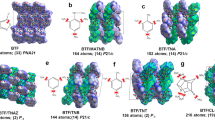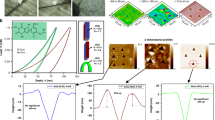Abstract
Organic cocrystal (also “co-crystal”), formed with two or more different components via non-covalent intermolecular interactions, possesses novel, unpredicted and unique properties, which are not the simple sum of those molecular components, e.g., with effect of 1+1>2. In this regard, organic cocrystals provide a distinctive strategy for the synthesis of novel multifunctional materials, and an important platform for exploring new fundamental physicochemical phenomena in molecular systems, such as high conductivity, ambipolar charge transportation, photovoltaic behavior, white light-emitting, room-temperature phosphorescence, nonlinear optics and ferroelectricity etc., with potential application even in liquid crystal engineering and drug industry.
中文摘要
本文简明扼要地介绍了“有机共晶”这个重要研究领域的兴起和发展过程, 在有争议的方面, 如共晶定义和如何判定分子排布等, 给出了作者独到的见解. 特别重要的是, 通过阐述该领域当前存在的问题和挑战, 结合分析最新的研究进展和结果, 使得人们对共晶的认识更为系统和深入. 基于此, 作者同时分析和指出了未来可能重点发展的研究方向.
Similar content being viewed by others
References
Coleman LB, Cohen MJ, Sandman DJ, et al. Superconducting fluctuations and the peierls instability in an organic solid. Solid State Commun, 1973, 12: 1125–1132
Ferraris J, Cowan DO, Walatka V, et al. Electron transfer in a new highly conducting donor-acceptor complex. J Am Chem Soc, 1973, 95: 948–949
Zhang J, Geng H, Virk TS, et al. Sulfur-bridged annulene-TCNQ co-crystal: a self-assembled “molecular level heterojunction” with air stable ambipolar charge transport behavior. Adv Mater, 2012, 24: 2603–2607
Kang SJ, Kim JB, Chiu CY, et al. A supramolecular complex in small-molecule solar cells based on contorted aromatic molecules. Angew Chem Int Ed, 2012, 51: 8594–8597
Kang SJ, Ahn S, Kim JB, et al. Using self-organization to control morphology in molecular photovoltaics. J Am Chem Soc, 2013, 135: 2207–2212
Tremblay NJ, Gorodetsky AA, Cox MP, et al. Photovoltaic universal joints: ball-and-socket interfaces in molecular photovoltaic cells. Chemphyschem, 2010, 11: 799–803
Lei YL, ** Y, Zhou DY, et al. White-light emitting microtubes of mixed organic charge-transfer complexes. Adv Mater, 2012, 24: 5345–5351
Bolton O, Lee K, Kim HJ, et al. Activating efficient phosphorescence from purely organic materials by crystal design. Nat Chem, 2011, 3: 205–210
Mazumdar S, Guo F, Meissner K, et al. A new class of collective excitations: exciton strings. J Chem Phys, 1996, 104: 9283–9291
Rao SM, Batra AK, Lal RB, et al. Mixed methyl-(2,4-dinitrophenyl)-aminopropanoate: 2-methyl-4-nitroaniline crystal-a new nonlinear optical material. J Appl Phys, 1991, 70: 6674–6678
Zyss J, Ledoux-Rak I, Weiss HC, et al. Coupling octupoles in crystals: the case of the 1,3,5-trinitrobenzene-triphenylene 1:1 molecular co-crystal. Chem Mater, 2003, 15: 3063–3073
Bosshard C, Wong MS, Pan F, et al. Self-assembly of an acentric co-crystal of a highly hyperpolarizable merocyanine dye with optimized alignment for nonlinear optics. Adv Mater, 1997, 9: 554–557
Horiuchi S, Ishii F, Kumai R, et al. Ferroelectricity near room temperature in co-crystals of nonpolar organic molecules. Nat Mater, 2005, 4: 163–166
Nguyen HL, Horton PN, Hursthouse MB, et al. Halogen bonding: a new interaction for liquid crystal formation. J Am Chem Soc, 2003, 126: 16–17
Reczek JJ, Villazor KR, Lynch V, et al. Tunable columnar mesophases utilizing C2 symmetric aromatic donor-acceptor complexes. J Am Chem Soc, 2006, 128: 7995–8002
Braga D, Maini L, Grepioni F. Mechanochemical preparation of co-crystals. Chem Soc Rev, 2013, 42: 7638–7648
Wöhler F. Untersuchungen über das Chinon. Annalen, 1844, 51: 153
Davey R, Garside J. From Molecules to Crystallizers. An Introduction to Crystallization. Oxford: Oxford University Press, 2000
Patrick CR, Prosser GS. A molecular complex of benzene and hexafluorobenzene. Nature, 1960, 187: 1021–1021
Desiraju GR. Crystal and co-crystal. CrystEngComm, 2003, 5: 466–467
Dunitz JD. Crystal and co-crystal: a second opinion. CrystEng-Comm, 2003, 5: 506
Lucassen ACB, Karton A, Leitus G, et al. Co-crystallization of sym-triiodo-trifluorobenzene with bipyridyl donors: consistent formation of two instead of anticipated three N···I halogen bonds. Cryst Growth Des, 2007, 7: 386–392
Harris KDM, Stainton NM, Callan AM, et al. Crystal engineering of hydrogen-bonded co-crystals between cyanuric acid and ‘diamide’ molecules. Investigations on the formation and structure of co-crystals containing cyanuric acid and oxalyl dihydrazide. J Mater Chem, 1993, 3: 947–952
Zhang J, Tan JH, Ma ZY, et al. Fullerene/sulfur-bridged annulene cocrystals: two-dimensional segregated heterojunctions with ambipolar transport properties and photoresponsivity. J Am Chem Soc, 2012, 135: 558–561
Boyd PDW, Reed CA. Fullerene-porphyrin constructs. Acc Chem Res, 2004, 38: 235–242
Kobayashi H, Nakayama J. The crystal structure of the charge-transfer complex of dibenzotetrathiafulvalene-tetracyanoquinodimethane, DBTTF-TCNQ. B Chem Soc Jpn, 1981, 54: 2408–2411
Mahns B, Kataeva O, Islamov D, et al. Crystal growth, structure, and transport properties of the charge-transfer salt picene/2,3,5,6-tetrafluoro-7,7,8,8-tetracyanoquinodimethane. Cryst Growth Des, 2014, 14: 1338–1346
Black HT, Perepichka DF. Crystal engineering of dual channel p/n organic semiconductors by complementary hydrogen bonding. Angew Chem Int Ed, 2014, 53: 2138–2142
Li J, Takaishi S, Fu**uma N, et al. Enhancement of luminescence intensity in TMPY/perylene co-single crystals. J Mater Chem, 2011, 21: 17662–17666
Frišcic T, Jones W. Recent advances in understanding the mechanism of cocrystal formation via grinding. Cryst Growth Des, 2009, 9: 1621–1637
Zhu W, Yi Y, Zhen Y, et al. Precisely tailoring the stoichiometric stacking of perylene-TCNQ co-crystals towards different nano and microstructures with varied optoelectronic performances. Small, 2015, 11: 2150–2156
Huang X, Zhang H. Molecular crystals on two-dimensional van der Waals substrates. Sci China Mater, 2015, 58, 5–8
D’Avino G, Verstraete MJ. Are hydrogen-bonded charge transfer crystals room temperature ferroelectrics? Phys Rev Lett, 2014, 113: 237602
Dillon RJ, Bardeen CJ. The effects of photochemical and mechanical damage on the excited state dynamics of charge-transfer molecular crystals composed of tetracyanobenzene and aromatic donor molecules. J Phys Chem A, 2011, 115: 1627–1633
Torrance JB. The difference between metallic and insulating salts of tetracyanoquinodimethane (TCNQ): how to design an organic metal. Acc Chem Res, 1979, 12: 79–86
Bandrauk AD, Truong KD, Carlone C. Optical and Raman spectra of single crystals of perylene-TCNQ charge transfer complexes. Can J Chem, 1982, 60: 588–595
Bandrauk AD, Truong KD, Salares VR, et al. Raman spectra of solid perylene–TCNQ complexes. J Raman Spectrosc, 1979, 8: 5–10
Zhu W, Zheng R, Fu X, et al. Revealing the charge-transfer interactions in self-assembled organic cocrystals: two-dimensional photonic applications. Angew Chem Int Ed, 2015, 54: 6785–6789
Zhu W, Zheng R, Zhen Y, et al. Rational design of charge-transfer interactions in halogen-bonded co-crystals toward versatile solid-state optoelectronics. J Am Chem Soc, 2015, 137: 11038–11046
Hains AW, Liang ZQ, Woodhouse MA, et al. Molecular semiconductors in organic photovoltaic cells. Chem Rev, 2010, 110: 6689–6735
Qin X, Dong HL, Hu WP. Green light-emitting diode from bromine based organic-inorganic halide perovskite. Sci China Mater, 2015, 58: 186–191
Gao Y, Wang JJ, Wu L, et al. Tunable magnetic and electrical behaviors in perovskite oxides by oxygen octahedral tilting. Sci China Mater, 2015, 58: 302–312
Author information
Authors and Affiliations
Corresponding authors
Additional information
Weigang Zhu was born in 1988. He is now a PhD candidate in the Laboratory of Organic Solids, Institute of Chemistry, Chinese Academy of Sciences (ICCAS). His research interest is design, synthesis and applications of organic cocrystals, including: (1) basic nucleation and growth mechanism of cocrystals and related controlled self-assembling; (2) advanced physicochemical properties of cocrystals, such as ambipolar charge transport, white-light emitting, lasering, non-linear optics, ferroelectrics and spintronics; (3) ultrafast exciton and molecular dynamics in cocrystals.
Huanli Dong is an associate professor of the ICCAS. She grew up in Shandong province, China. She received her PhD degree from the ICCAS in 2009 after she got her MSc degree in Fujian Institute of Research on the Structure of Material, Chinese Academy of Sciences in 2006. She is presently focusing on the self-assembling of molecular materials and the application of molecular materials in optoelectronic devices, and she has more than 90 refereed publications with citation over 2500 times (H index=22).
Wen** Hu is a professor of the ICCAS. He received his PhD from the ICCAS in 1999. He then joined Osaka University as a research fellow of Japan Society for the Promotion of Sciences and Stuttgart University as an Alexander von Humboldt. In 2003 he worked for Nippon Telephone and Telegraph, and then returned to ICCAS and was promoted as full professor. His research focuses on molecular electronics and he has more than 350 refereed publications with citation over 10000 times (H index=53).
Rights and permissions
About this article
Cite this article
Zhu, W., Dong, H., Zhen, Y. et al. Challenges of organic “cocrystals”. Sci. China Mater. 58, 854–859 (2015). https://doi.org/10.1007/s40843-015-0099-1
Received:
Accepted:
Published:
Issue Date:
DOI: https://doi.org/10.1007/s40843-015-0099-1




